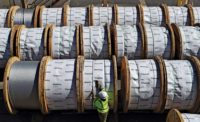All branches of the U.S. Dept. of Defense (DOD) combined forces to attack an engineering problem that holds the lives of 70,000 people in the balance. Hurricane Maria’s heavy rains caused Puerto Rico’s 984-ft-long, 120-ft-tall hydroelectric, earthen Guajataca Dam to overflow its banks on Sept. 22, damaging its spillway and forcing federal engineers to get creative in their approach to stabilizing the hard-to-reach structure.
“When we arrived on site it was four days after the hurricane and approximately 50% of the spillway channel was eroded and gone, with 2 feet of water flowing through the spillway,” says Dan Blaydes, lead engineer for dams and levees, Jacksonville District, U.S. Army Corps of Engineers, which provided technical support to the owner, Puerto Rico Electric Power Authority (PREPA), and its contractors. Another 10% of the 646-ft-wide spillway channel was lost during the ensuing 20 days that it took crews with the Corps and DOD to stabilize the dam, says Blaydes. “Most of it happened very quickly after the hurricane and the flows were super high,” he says.
The reservoir of the dam lies between the municipalities of Quebradillas, Isabela and San Sebastián and was built to hold back 55.3 million cu yd of water. It has been labeled “high hazard” in the National Inventory of Dams (NID)—the same rating given to Puerto Rico’s 37 other dams. Guajataca Dam was built in 1929 and last inspected in 2013, according to the NID.
“Hurricane Maria blew through, elevating the lake level and causing it to use the spillway, and the volume of water undercut and began to erode the spillwall,” says Col. James DeLapp, commander of the USACE Mobile District, who was in Puerto Rico during the emergency stabilization operation.
The dam’s spillway channel is a concrete-lined channel with a fixed crest weir. At the bottom of the dam there was a modification of an earthen stabilization berm, says Blaydes. The dam had some stability issues, and PREPA was trying to address those with the berm before the hurricane hit. That berm covered a portion of the dam, but the flooding eroded the stability berm and continued on in progressive erosion with some progressive upstream head-cutting action that removed 50% of the spillway channel, says Blaydes.
“We immediately started with plans of action on how to attack and get materials to the dam and stabilize it.” But the dam’s location in a hard-to-access, mountainous area of the island combined with the recently downed power, transportation and communications networks presented the Corps with unprecedented obstacles.
Clearing a Path
“The construction challenges were significant,” says Blaydes. There was no water and no power or communications when the Corps arrived. Blaydes also says that most roads to the site were cut off. Puerto Rico Highway 119 runs over the crest of the dam and was flooded and impassable, and the Puerto Rico Highway 47 bridge downstream of the dam was washed out and impassable. So the Corps was forced to use residential and rural roads unsuited for truck traffic. “We were driving trucks on them anyway,” says Blaydes. It was the only option.
“Our biggest challenge is logistics,” says DeLapp. His team was forced to clear a path through a mountainous winding route to the dam. But even with limited automobile access, helicopters became necessary to carry out construction. “You can’t get trucks down there to push rubble in because it’s still spilling water,” he says.
The Air Force, Marines, Navy and Army National Guard along with the Puerto Rican National Guard joined the Corps to fly in 502 Jersey barriers and 1,338 super sack sandbags and riprap to head off the threat of imminent flooding, DeLapp adds. Helicopters from all branches of the DOD flew in the material in shifts, shoring up the spillway until flooding began to slow. The dam erosion partially covered the main outlet point of the outlet works with rock and soil, so the Corps had to remove material blocking that outlet to help restore the flow.
Concurrently, the Corps worked to install 18-in.-dia diesel water pumps to draw down the crestline of the water, says Blaydes. The pumps also refilled a canal that supplies 250,000 residents with drinking water from the Guajataca reservoir. That water supply ran through a 54-in.-dia pipe located beneath the spillway that was severed during flooding. The Air Force brought out its C-130 Hercules cargo plane to truck the first two pumps, and the rest were barged down from the states.
The big show of manpower and helicopters brought about another difficulty: site security.
“While it was flowing it was quite a sight to see, and the helicopters themselves brought a crowd,” says Blaydes. With several dozen local residents coming to the site daily out of curiosity, state and local police came out to perform crowd control. “We still have a problem with that,” Blaydes adds, with locals regularly walking out onto the site to check on progress. “It was worse when the helicopters were up there though.”
With water, power and communications grids down on most of the island, the Corps based its operations in San Juan, a 90-minute drive from the site. “That distance in itself was a trial,” says Blaydes. And the final test was getting materials to the island. To source enough super sack sandbags and Jersey barriers to shore up the spillway and the slings and shackles needed to lift them, the Corps called upon its branches across the U.S. The Rock Island, Ill., and New Orleans districts combined with commercial suppliers on the mainland to fill the orders from the Corps.
Act Two
With the pumps running and the reservoir drawn down, the spillway became temporarily stabilized on Nov. 20. Since that time, the Corps has begun phase two of the dam remediation: gathering information about the stability of the dam and developing plans to put out a request for proposal for further corrective work, says Brenda Calvente, project manager for the Corps’ Jacksonville District.
As the next hurricane season looms, the Corps is trying to move as quickly as it can to strengthen that channel, says Blaydes, who was part of planning the next steps in remediation. “We hope something will be rolling in March.
Stabilizing the spillway and dam in stage two will protect against a 100-year rain event, says Calvente. “Our schedule is to have the critical work finished by July of this year and to complete stage two by July of 2019,” she says. With that complete, stage three will begin, which is aimed at protecting against a 1,000-year rain event, Calvente adds.
“The dam has other issues like seismic issues and soil stabilization,” says Calvente. “Stage three will ensure the dam isn’t going to fail in the case of another Maria event.”
For now, the first step to firm up the dam is to grout, anchor and seal the spillway slabs. Currently, the weight of the concrete alone is holding the slabs in place, and there are voids beneath them. “There are some cracks in the slabs, and water can get in and flow underneath,” says Blaydes. After the slabs are sealed, 5-meter-deep, 6-in.-dia holes will be drilled through them and a 1-in.-dia rod with a nut and plate will tighten them up. Contractors will install shotcrete and earth anchors on the exposed earth slopes of the dam to protect the surface from erosion in case of another spillway flow. “Then we’ll grout the areas where we dropped the Jersey barriers into a solid mass for stability. We’ll also reconnect the water supply that was severed so we can turn these pumps off,” Blaydes says.
The outlet works are also in need of repair. “There’s a damaged inlet gate on the intake tower to be replaced, and the high pressure gates of the hydraulic controls need repairs and modernizations,” says Blaydes.
Further downstream, contractors will reinforce the spillway channel with a large volume grout placement as well as construct an energy dissipator and a plunge pool to stop erosion. “We’re going to create two rockfill berms on each side of the channel and a rockfill weir and a hydraulic jump in the plunge pool,” says Blaydes. Once the flow is restricted from supercritical to critical, the job will be done, he says.












Post a comment to this article
Report Abusive Comment